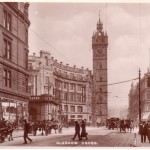 In its earliest days, Glasgow was a small fishing village by a shallow and easily forded River Clyde and it remained this way until the Sixth Century AD when Saint Mungo founded a religious settlement by the Molendinar Burn on the hill to the north. A monastery was built and as the settlement grew, it became recognized more widely, so much so that Saint Columba came to visit. During the centuries that followed, the small township gradually spread southwards along the line of the burn and eventually linked up with the fishing village by the river. The paths connecting the settlements became increasingly well worn until they took the form of lanes and eventually became streets. The first centre of Glasgow was around the site of the monastery and then later the Metropolitan Church ( St. Mungo’s Cathedral ) which was built nearby. Just to the south of it, an old Roman road crossed the Molendinar Burn and those parts to the east and west of the High Street would become the Drygait and Rottenrow respectively. These three streets are the oldest in the city. To the south, a second centre was developing, a lay centre where four streets met at right angles, forming the cross that would become Glasgow Cross.
In its earliest days, Glasgow was a small fishing village by a shallow and easily forded River Clyde and it remained this way until the Sixth Century AD when Saint Mungo founded a religious settlement by the Molendinar Burn on the hill to the north. A monastery was built and as the settlement grew, it became recognized more widely, so much so that Saint Columba came to visit. During the centuries that followed, the small township gradually spread southwards along the line of the burn and eventually linked up with the fishing village by the river. The paths connecting the settlements became increasingly well worn until they took the form of lanes and eventually became streets. The first centre of Glasgow was around the site of the monastery and then later the Metropolitan Church ( St. Mungo’s Cathedral ) which was built nearby. Just to the south of it, an old Roman road crossed the Molendinar Burn and those parts to the east and west of the High Street would become the Drygait and Rottenrow respectively. These three streets are the oldest in the city. To the south, a second centre was developing, a lay centre where four streets met at right angles, forming the cross that would become Glasgow Cross.
In the period leading up to the Reformation, Glasgow Cross was known as Mercat ( Market ) Cross after the market that was held there in the wide open space where the four streets met. These were the Tronegait to the west, named after the trone or balance that was installed there for weighing goods, Gallowgait to the east, Street from Mercat Cross to the Metropolitan Church to the north, and Walkergait to the south, the latter named after the waulkers who bleached cloth. Later, the street to the north would be renamed the High Street after the High Kirk and Walkergait would become the Salt Market, after the salmon curing. Glasgow has never been a walled city and the term “gait”, also spelled “gate”, does not refer to a gated entry but instead is an old Scottish word meaning “the way to”. Hence the Briggait is the way to the bridge, in this case the Old Bridge or Brig, Bishop Rae’s Bridge, which was the first major bridge across the Clyde in Glasgow. As Glasgow Cross grew in commercial importance, particularly from the 16th Century onwards, its development surpassed that of the area surrounding the Cathedral. The ingress of London Road, originally called London Street, came much later, in 1824, and opened into the Saltmarket, connecting Glasgow Cross with Great Hamilton Street.
This printed colour postcard shows Glasgow Cross in the early 1900’s when the Tolbooth Steeple was still part of a larger building. The steeple itself dates from 1626/7 and was built together with the original Tolbooth which was used to house the Town Clerk’s office, the council chamber and the city jail. Eventually, as the needs of the civic government increased, these facilities proved insufficient and the property was sold in 1814 and subsequently rebuilt to a design by David Hamilton. Latterly, the building served as the premises of John A. Bowman, auctioneer and valuator, as seen here, until it was demolished in 1921, leaving the steeple isolated where it remains to this day. There used to be a passageway for pedestrians through the base of the steeple but this was closed off once the steeple stood alone. The red sandstone building on the right of the picture was also demolished in the early 1920’s and the site used for construction of the Mercat Building (1925-28) and the Mercat Cross (1929). ( Postcard published by M. Wane & Co., Edinbro. )
In this scene, taken before 1910, we are looking west from the Gallowgate across Glasgow Cross, and down the Trongate. There are military personnel in the right foreground, including one soldier in full dress uniform with a kilt, spats and a chest full of medals. Perhaps a recruiting campaign was underway and there was a recruiting office in nearby Rendezvous Court. Beyond the soldiers, the Tolbooth Steeple and Building are visible across the entrance to the High Street. The curious ornate octagonal building on the left of the picture is the Caledonian Railway building ( 1896 ), designed by J. J. Burnet and part of Glasgow Cross Station whose platforms were below street level. The wrought ironwork on the other side of the building enclosed a ventilation shaft that allowed smoke to escape from the tunnels below. Beyond this, the mounted statue of King William III, Prince of Orange, better known as King Billy, looks down the Trongate, taking in the view with the Tron Steeple on the left. King Billy’s statue was in the Trongate for 163 years before it was taken down in 1923 and, after a short period in storage, erected in the Cathedral precinct in 1926. ( Postcard published in the Philco Series. )
This view, taken around 1910 from London Street*, is looking down the other side of the island on which Glasgow Cross Station building stands with the Trongate beyond. The Saltmarket is on the left of the picture and the original Glasgow Cross is off camera to the right. Men predominate in this scene, most of whom appear to be gathered in small groups on the street corners. R. E. Wright, the ironmonger and shopfitter, enjoys a good location on the Saltmarket corner and, on the floor above, Dr. Tracey is practicing American Dentistry, which must have seemed very modern to the people of Glasgow’s East End. There was plenty of business for dentists in Glasgow and they often took first floor premises in tenement buildings in commercial locations. ( Postcard published in the J. M. Caledonia Series. )
* Later renamed London Road in the 1920’s.
This fine photograph dating from around 1912 shows the view looking north from the Saltmarket towards Glasgow Cross. Perhaps taken early on a Saturday morning, there is a mixed crowd of people out with some family groups and also some men and women on their own. In the foreground, there is a touching scene of a young woman and her baby wrapped in a plaid shawl standing by the kerb. Most of the people are heading up the street towards the Cross, possibly to the Caledonian Railway station and the shops in the Trongate. Tramcar number 774, a “blue” car en route to the Botanic Gardens, is dropping off passengers before turning left into the Trongate. The lorry by the kerb on the right is in the service of MacFarlane, Paton & Co., a firm specializing in jams, jellies and marmalade. It is parked outside the Caledonian Railway Parcels Receiving Office. The single storey building next door is the location for James Coggans’ famous bar “The Coat of Arms” on the corner with London Street. The finely detailed wrought iron lamp standard on the right is serving two roles, both as a light bearer and as a support for the tramwires. It appears to be leaning forward under the tension. At the time this photograph was taken the globes on the lamp standards were in the process of being replaced and newer ones had already been installed at the Cross. ( Postcard published by E. A. Schwerdtfeger & Co., London E. C. and printed in Berlin. )
The Tolbooth Steeple now stands alone in this printed view of Glasgow Cross as seen from the Saltmarket near the junction with St. Andrew Street in 1929/30. The space to the left of the Steeple is now occupied by the new Bank of Scotland Building designed by A. Graham Henderson. Two “white” tramcars, serving the route between Springburn and the southern suburbs of Mount Florida, Cathcart and Netherlee, are passing each other at the Cross. Before route numbering was adopted in 1938, Glasgow’s trams carried distinctly coloured upper panels so that passengers could easily identify their route. This system worked well as long as no cars of the same colour were on a section of the same track and yet serving different routes. In this scene we see a rare exception. The “blue” car in the foreground, on the service from Rutherglen to Kirklee has an X above its destination board because for a short part of its journey in Hope Street, it would be on the same track as used by another blue car service, Renfrew/Linthouse – Keppochill Road/Lambhill/Springburn. This X identification was introduced on 23 October 1928 and discontinued once the route numbering system was introduced in 1938. ( I am grateful to Mr. Hugh McAulay of the Scottish Tramway & Transport Society for this information. )
The vast majority of people in this scene are men, dressed in their working clothes and all wearing bunnets. Not a single bowler hat is to be seen. Very few women are present yet it is clear that hemlines are now at knee level, or well above in the case of one female crossing the street. Another woman, standing by the kerb on the right is wearing leggings and light-colored shoes, clearly decades ahead of her time. ( Postcard published by E. T. W. Dennis & Sons. Ltd., London & Scarborough. )
In this photographic view, also taken in the mid to late 1920’s, the buildings and pedestrians are portrayed with far greater clarity. Again, all of the men are in caps including the man in the right foreground who is dressed in a three-piece suit and sporting a bow tie. R. E. Wright, the ironmonger and shopfitter on the corner, is offering a wide range of goods including brushes, bicycles, clocks, watches, mincers and wringers. There were no spin dryers in those days. Washing had to be hand-wrung or put through the mangle and then hung up to dry. The single-storey building on the left with the balustrade on top is the new Glasgow Cross Station, serving the line below street level. This was the second such building to occupy the site and was completed in 1923. An early bus with pneumatic tyres is passing the Bank of Scotland and the man with the placard is advertising a sale of linoleum at premises on the Gallowgate. ( Real Photo Series postcard by Pelham )
A white-coated policeman is directing traffic in this early 1930’s view of Glasgow Cross taken from the Saltmarket. Apart from three women on the left, waiting to cross the street, the scene is vastly male-dominated. Many men were out of work at this time as a result of the Great Depression and cities such as Glasgow that were so dependent upon heavy industry were particularly badly affected. Robert Wright’s ironmongery and shopfitting business is still on the corner across from Glasgow Cross Station but it is not clear if Dr. Tracey is still practicing American Dentistry above. On the right of the picture, the large shoe identifies John Moffat’s long-established shoe and clog shop at 19 Saltmarket. The ornate lamp standards that bore Glasgow’s first electric street lights have now been replaced with a more utilitarian design. The “white” tramcar approaching the camera, en route to Mount Florida from Springburn, has recently been modernized with the complete enclosure of the upper deck, the fitting of a new destination box and a bow collector for power pickup. It has just passed a tanker lorry with Redline – Glico, a petroleum and motor oil company that was formed in 1931 from the merger of the Redline Motor Spirit Co. Ltd. and Glico Ltd. ( Postcard published by Miller and Lang in their National Series. )
It is now 1949 and Robert Wright’s ironmongery is still supplying hardware on the Saltmarket corner but Dr. Tracey has moved out from the premises above. Moffat’s shoe shop is still in business on the right. There are now more women pedestrians and groups of men are no longer seen loitering on the street corners. The tram services have recently been withdrawn from the High Street and the overhead wiring installed for trolleybus operation. One of Glasgow Corporation’s new 6-wheel trolleybuses ( TB 24, FYS 724 ) is heading north from the Saltmarket on route 102. The absence of destination and route screens from the rear compartments would suggest that this vehicle was on a test run or being used for driver training. Service 102 was the first trolleybus route to be inaugurated in Glasgow, beginning just after noon on Sunday 3rd April, 1949 when the first vehicle left Larkfield Garage bound for Riddrie. These early trolleybuses, intended as tram replacements, were delivered with London Transport – style trolleybus transfers as seen here but they later had to be removed, allegedly because of a copyright complaint from L.T. A Scammell mechanical horse, in the service of the recently nationalized British Railways, is heading towards the camera with a heavy load, having come down the High Street from one of the railway goods depots. It should be noted that the building on the Gallowgate corner across from the Tolbooth Steeple has been reduced in height to two storeys from four since the previous photograph was taken. ( Postcard published by Miller and Lang in their National Series. )
The sun was shining brightly when this photograph of Glasgow Cross was taken in the early 1960’s. Two Glasgow Corporation Daimler buses are about to pass each other on route 37 between Springburn and the southern suburbs of Croftfoot and Castlemilk. The buses are in different liveries as it was a time of transition around 1960/1. As can be seen from the overhead wires, the trolleybuses were still in service on the High Street routes and they would not be withdrawn until April 1966. Women, most of whom are not wearing hats, are busy patronizing the selection of small shops that abound on the Saltmarket. Only one solitary man is wearing a cap and he is walking around the back of the bus on the left. It is not possible to see if Robert Wright is still in the ironmongery business but Moffat’s shoe sign has gone. The buildings continue to darken because of soot deposition although the Clean Air Act introduced in 1956 helped to slow down this process. ( Postcard by Miller & Lang Ltd., Glasgow. )
The newly-built Mercat Building and Mercat Cross take centre stage in this early 1930’s photograph taken from the entrance to the Trongate. We are looking east with the Gallowgate on the left and London Road on the right. The Mercat Building, designed by A. Graham Henderson as part of a master plan for the redevelopment of Glasgow Cross, was completed in 1928. Its deeply modelled façade fronted by two large Ionic columns provides both drama and grandeur at this point of entry to Glasgow’s East End. In comparison, the Mercat Cross, designed by Edith Burnet Hughes and completed in 1929/30, is modest and unassuming. It was paid for by Dr. William Black and his wife and inaugurated on 24 April 1930 in the presence of the Lord Lyon King of Arms and the City Council. With its proclamation platform and balustrade encircling the column bearing a heraldic unicorn, it replaced the original Mercat Cross that had been removed in 1659. The twin spires of St. James United Free Church at the corner of London Road and James Morrison Street are visible on the right. ( Postcard published by J. & M. Co. Ltd., Caledonia Series. )
The photographer must have been up in the Tolbooth Steeple in order to take this picture for Valentine’s in 1932. The Mercat Building now bears its name in letters below the columns and Harris Lebus, the renowned manufacturer of fine Arts & Crafts furniture, has premises on the ground floor front. Groups of men, almost certainly unemployed, are gathered together near the Mercat Cross seeking comradeship at this time of economic crisis. Perhaps Glasgow Cross was one of the places that employers would visit if they were looking to hire. A more fortunate individual wearing a top hat is standing by the kerb outside the Luncheon Rooms on the Gallowgate, waiting to hail a cab. The train crossing the bridges over London Road and the Gallowgate comprises local L.M.S. suburban carriages and is probably outbound from St. Enoch Station on its way to the eastern suburbs. ( Postcard published by Valentine & Sons, Ltd., Dundee. )
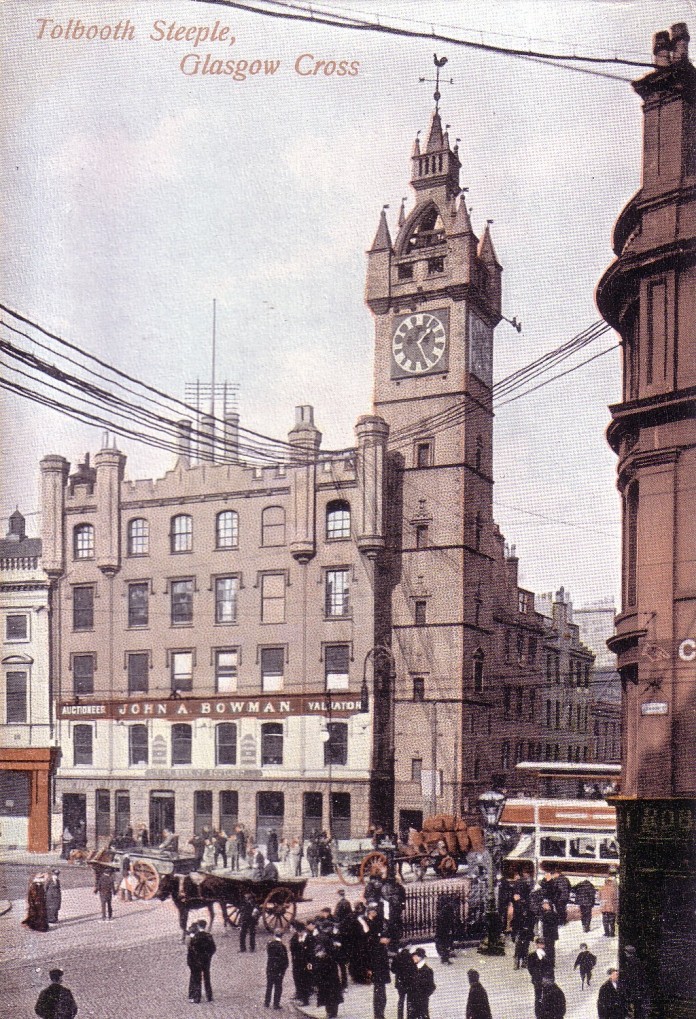
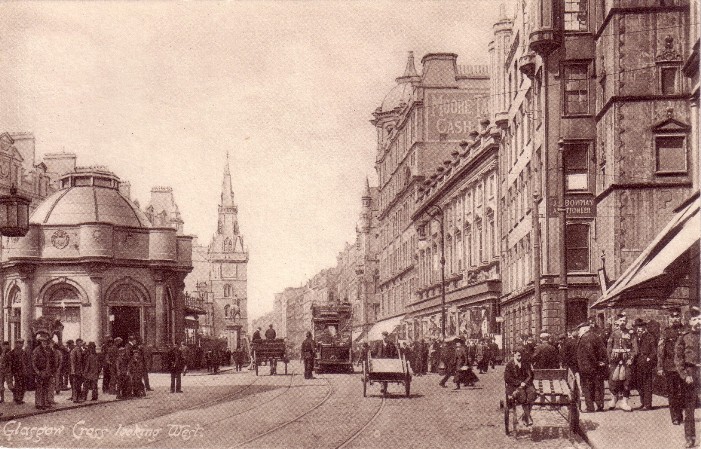
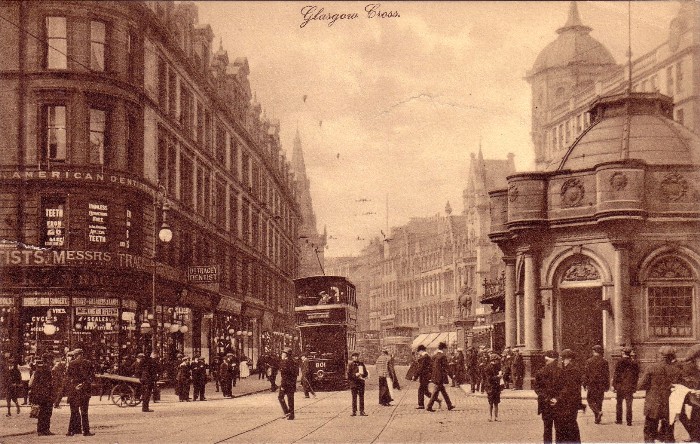
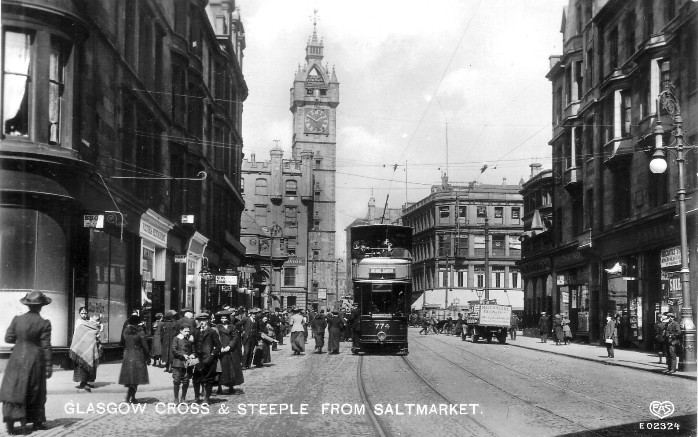
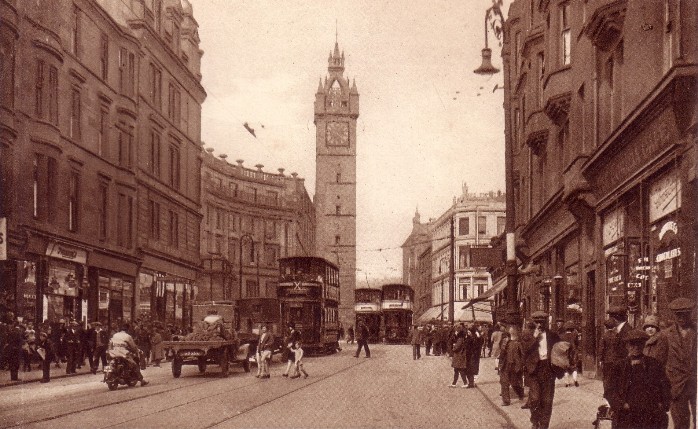
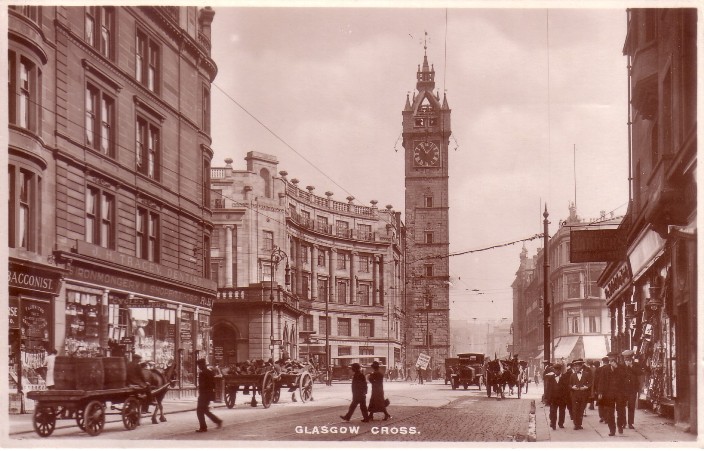
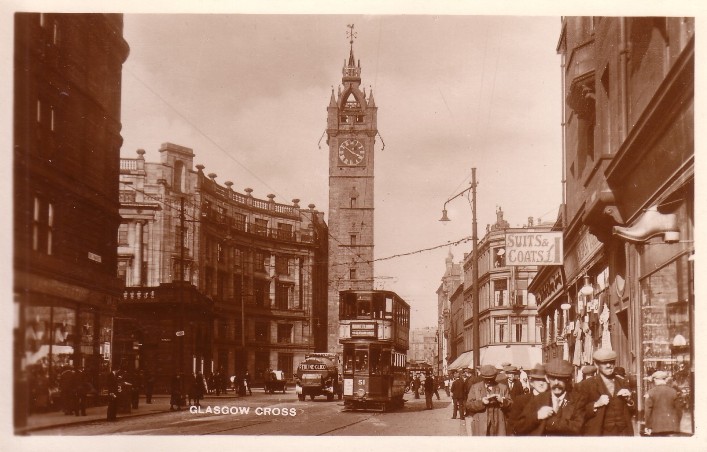
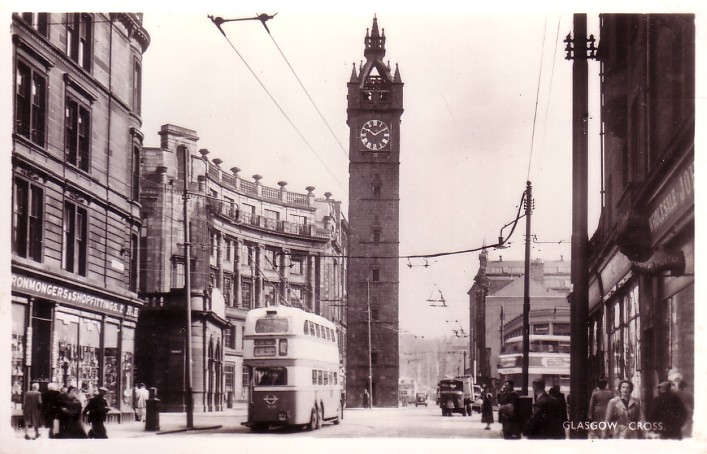
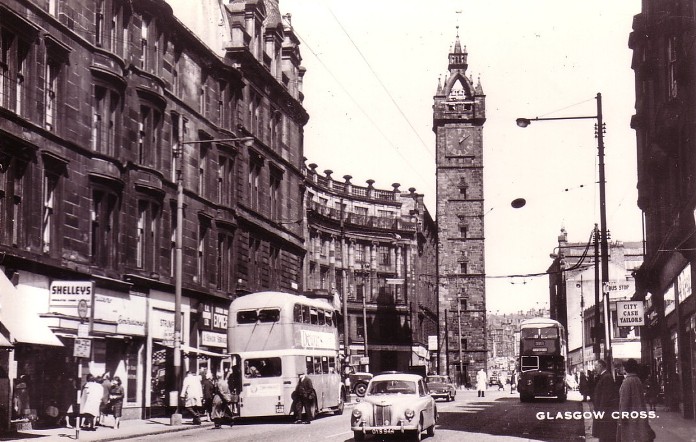
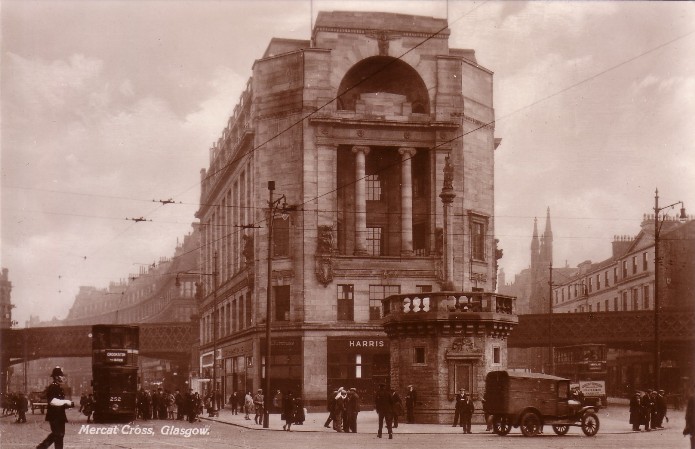
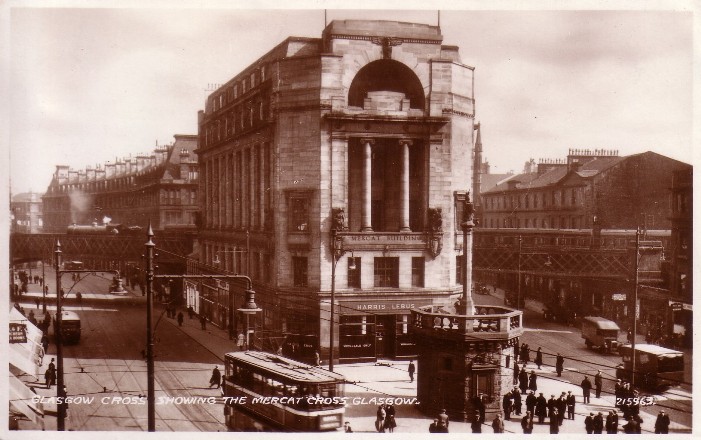

{ 1 trackback }
{ 32 comments… read them below or add one }
It looks so full of life. Such a stark departure from today! I really like the building in the second picture opposite the current HBOS. Have you ever seen the proposals for the relocation of the Tolbooth to the site of the current Mercat Cross?
Hi Sam,
I agree with you. Glasgow Cross was the most important intersection in the early history of the city. Only when the city expanded westward did it lose some of its prominence.
When the building currently occupied by HBOS was constructed, the intention was to build a matching one on the other side of the High Street but obviously that didn’t happen and now we have complete asymmetry.
Believe it or not, there were plans published in a 1915 report, to dismantle the Tolbooth steeple and relocate it immediately east of where the Mercat Cross now stands, thus opening up the High Street for better traffic flow.
It was a bustling place even in 60’s when I was living in Bridgegate. I really do however think the Krazy House building should be opened up as a hub for the City Union Line and Argyle Line. With all the regeneration at Collegelands, it would help sustain it and at same time bring the Trongate back to life again. The City Union Line must be opened up as a north /south link, maybe as light rail etc. We are blessed with the infrastructure that’s already in place. It keeps the cost down.
Hi Jim,
Thank you for your suggestion. Perhaps you should contact the planners. I believe the Krazy House used to be in the Mercat Building. There is a very interesting thread about it on the Hidden Glasgow website. http://www.hiddenglasgow.com/forums/viewtopic.php?t=161&highlight=crazy+house
Robert Wright’s ironmongery was eventually taken over by Archie Wright (my Grandpa). He later opened a shop in Clarkston but it got destroyed after the Gas Explosion. The building today is a cafe.
Thank you Craig for the update. Do you know the approximate dates when your Grandpa was running the ironmongery at Glasgow Cross as he may have been there when some of the more recent photographs shown here were taken? I’m very sorry that his business was destroyed in the huge gas explosion in Clarkston after he had relocated there. That was a terrible tragedy. Reference is made to it in Douglas Nisbet’s illustrated book “Old Clarkston and Netherlee”.
My grandpa took over the business in the late 1950s after Robert Wright passed away and he near enough recognizes all of the pictures as he worked in the shop after coming out the navy and before eventually taking over the business. The shop in town closed around 1974. However the shop in Clarkston continued for around 12 years.
Thank you for the additional information. Your grandpa would have been running the business by the time the photo featuring the two Glasgow Corporation Daimler buses was taken in 1960/61.
Hi Chris,
Two anecdotes, regarding the Mercat Building, and the road to the right.
I did business with” Krazy House” in the 1960’s when I had my own fashion label. The buyer there was a wonderful, larger than life woman called Marsha Purtell, a lady of a certain age, who I suspect, had gone on holiday to Canada for 2 weeks, and returned with a perfect American Mid-West accent. She was small, rotund, and had a jet black “bee hive” hairdo that doubled her height, and wore sequinned dresses during the day. She terrified the life out of suppliers and staff alike, but was a true one-off, who knew her business inside out. Theirs’ was a stack ’em high, sell ’em cheap policy,and was probably the forerunner of “What Every’s”.
My granny in the 1930’s was another one of a kind. Widowed, with eight children, she ran the family coal-merchants business, developed property and in the 1930’s owned a restaurant, in the road to the right of the Mercat Building, just under the railway bridge. Having just opened, a couple of shady characters came in to offer her “protection”, obviously seeing a single lady as a soft touch! She amiably asked them to return the next morning to be greeted by her 5 adult sons, including two fly weight boxers, explaining she had all the “protection” she needed. Her windows remained intact for the duration of her tenure.
Willie
Hello Chris,
I have discovered that I may have ancestors who lived in Dumbarton. They would have resided on Glasgow Road around 1920 and then later on Newhall Street. Their names were Margaret Purvis, nee McFarlane, and William Henry Purvis. I would be grateful for any information.
Thank you.
Lorraine
Archie Wright, owner of R. E. Wright and Son, Glasgow Cross is now 91 years old and enjoyed reading this article and viewing the photographs. The business was started by his Grandfather in 1883 and continued to trade until 1982, 99 years of trade as a family business. Archie still goes to the newsagents at Glasgow Cross for his pipes and tobacco. Yes, he still continues to smoke at the age of 91.
David
Hi David,
Thanks for sharing this information about your family. It’s good to know that Archie enjoyed the article and that he still visits Glasgow Cross for his pipes and tobacco.
Best wishes,
Chris
In researching WWII RAF history I have come across the name RAF Gallowgate which is mentioned as an RAF hotel. Can anybody confirm if RAF Gallowgate did exist during the period and, if so, it’s location. Thanking you in advance.
Regards,
DHS
Bedford
Hi Chris,
I have a wood trunk with dovetail joinery and brass corners. The brass keyhole cover reads “A.R. Henderson, 78 Gallowgate, Glasgow.” Anyone have info on Henderson?
James
Hi Chris,
When I was around 10 or 11 years old I read about the Tontine Hotel which stood in Trongate near to the Cross. This hotel had a row of very large gargoyle-type faces along its front and when it was demolished some of the faces ended up in the People’s Palace. I was fascinated by the story that one or more of the faces were lost and for many years after I heard this story I always kept my eyes peeled from the upstairs windows of various buses, searching for the missing faces. I don’t know if they were ever found, eventually I grew up and had other interests.
Lex
Hi James,
Thank you for your question. I checked the 1927 Glasgow Directory which is accessible online and A.R. Henderson & Co. Ltd., is listed at that address, so they were in business at that time. Apart from that, I have no further information.
Best wishes,
Chris
Hi Lex,
Thanks for sharing this information and your experience.
Best wishes,
Chris
Hi Chris,
I’m a volunteer researcher with Glasgow Museums currently researching the architect John Keppie. I was hoping to use your photograph of the Mercat Cross building in my report. I would of course acknowledge the source. The research I do is on the donors of paintings, sculpture, etc to the Glasgow museums and is not generally for publication although there have been a few exceptions to that in the past. The Keppie report is currently for internal use only and will go to Kelvingrove and the Glasgow Art Club whose archives I’ve been able to access.
Regards,
George Manzor
Hello George,
Thank you very much for your inquiry and you are most welcome to use the photograph.
Best wishes,
Chris
Hi Chris,
Thank you very much. I should also say that I only recently came across your site and have enjoyed it very much. Being a senior citizen of Glasgow the contents are interesting and evocative.
Best Wishes.
George
Hello Chris,
I was born in Guest Street in Anderston in 1957. This street was at the bottom of Elderslie Street, near St Vincent Street. I have been searching for a map showing this street. Apparently before it was called Guest Street, it was Hill Street. I was wondering if you have any maps showing Guest Street. I think it was knocked down in the early 1960’s.
Ann
Hello Ann,
Thank you for your inquiry and please forgive my delay in replying. I have consulted the Godfrey Old Ordnance Survey Maps for Glasgow and Lanarkshire. Anderston is covered in the Central Glasgow map, for which there are 1896, 1913, and 1934 editions. The first two editions show Hill Street in Anderston but in the 1934 edition, the name has been changed to Guest Street, so clearly the change took place sometime between 1913 and 1934. If you wish to obtain brand new copies the maps, they can be purchased online through eBay for around 3 Pounds each. Please note that the dates on the front of the maps refer to the photographs on the cover and are not necessarily the dates of the maps within, but they are close.
Best wishes,
Chris
Hello Chris,
My great-uncle was a professor of French in the late 19th Century: Professor Hector Rey, University of Glasgow.. He died in 1920 after being injured by a tram!
His son Loris worked as a sculptor and chiselled some stones of the Mercat Cross.
If you have information, I shall be delighted.
Best regards,
J. C. Rey
Hello J. C.,
Thank you for your inquiry. I did an online search and found these links to information about Loris Rey. I hope they will be of help.
https://sculpture.gla.ac.uk/view/person.php?id=msib2_1217497456
http://artdaily.com/news/4346/The-Henry-Moore-Institute-Presents-Loris-Rey#.Wun0GSOZOCQ
Best wishes,
Chris
Dear Chris,
My name is Rania and I’m a researcher for STV Studios.
We are currently filming Inside Central Station for the BBC and looking to cover some Glasgow Cross history. I would love to get the chance to get in contact with you about this.
Looking forward to hearing from you.
Kindest Regards,
Rania
Dear Rania,
Thank you for your inquiry and interest in Glasgow History. I will be in touch shortly via email.
With best wishes,
Chris
Hi Chris,
I came across your article about Glasgow Cross and, in particuliar, the sign featuring Dr. Tracey, Dentist in one of your photos. My father was born in the High St. in 1933, near the Old College Bar. l would be interested in any further information on Dr. Tracey.
Paul Tracy
Hello Chris,
I’ve been doing a family search and have found out that my great grandfather, William Harkness Moffat, was a shoe maker in the 1800’s. He lived and worked at 8 – 10 St. Vincent Street and in the Saltmarket. I’m trying to find photos and any information as I’m kind of stuck! I would appreciate if you could help, but I understand life is so busy!
Thank you and warm regards,
Ishbel Cumming nee Moffat x
Hello Ishbel,
Many thanks for your inquiry regarding your great grandfather, William Moffat. I checked the family name and employment in different issues of the Post Office Annual Glasgow Directory, published during the 1800’s and accessible online. In the General Directory, the name of the person is listed first, then the place of work, followed by the home address. The directories refer to the person’s house but it could be that the dwelling may have been rented accommodation, possibly rooms or flats, especially if the home address changed frequently over the years.
You will notice in the listings that the place of work for your ancestors during the latter decades of the 1800’s was consistently 9 Saltmarket. You will also notice the changing names, from William Moffat to John Moffat and subsequently J. H Moffat and then John Moffat jun.
If you wish to explore this approach further, simply search for the desired year in the Post Office Annual Glasgow Directory, then scroll down the page list to search for family names in the General Directory and occupations in the Trades List.
Post Office Annual Glasgow Directory, 1840-1841
Page, 177: Moffat, William, last and boot-tree maker, 108 Stockwell Street.
Post Office Annual Glasgow Directory, 1860-1861
General Directory, page 211: Moffat, John, clog manufacturer 9 Saltmarket; house, 133 London Street.
Post Office Annual Glasgow Directory, 1870-1871.
General Directory, page 271: Moffat, J. H. clogmaker, 9 Saltmarket; house, 8 Craignestock Place.
Post Office Annual Glasgow Directory, 1880-1881
General Directory, page 388: Moffat, J. H. clog and boot manufacturer, 8, 9, and 10 Saltmarket; house 131 Main St, Anderston
Post Office Annual Glasgow Directory,1890-1891.
General Directory, page 452: Moffat, John jun., clog manufacturer, 9 Saltmarket; house, 6 London Street.
I hope this helps.
Best wishes,
Chris
Hi Paul,
Thank you for your inquiry and it reminded me of questions I have about the American Dentistry being practiced at Glasgow Cross around the early 1900’s by Dr. Tracey and his associate(s).
Some notable advances in dentistry were made in the United States in the late 1800’s/early 1900’s including the use of cocaine as a local anesthetic and the development of crowns as dental restorations. I wonder if Dr. Tracey had incorporated these advances into his practice.
With respect to Dr. Tracey himself. Was he an American or had he been trained in part in the USA where the degrees awarded for dentistry are doctorates? ( DMD, Doctor of Dental Medicine; DDS, Doctor of Dental Surgery ). At the time the photo at Glasgow Cross was taken, most dentists in the UK were Licentiates in Dental Surgery (LDS) and they would have been addressed as Mister and not as Doctor. Even to this day, it is extremely rare to encounter a dentist in the UK who has a doctor’s degree in dentistry.
I estimate the date of the photo to be circa 1910 so I consulted the Post Office Annual Glasgow Directory for 1910 and looked up Dr. Tracey in the General Directory and also under Dentists in the Professional Trades Directory.
The alphabetical list of the names of persons and businesses and their addresses/locations starts at page 59.
Page 669 lists Tracey, Dr. T. F., dental surgeon, 312 St. Vincent Street, also at 5 Trongate ( Glasgow Cross ).
The Trades Index of Dentists and Dentistry is on Pages 1170 and 1171.
Page 1171 Dr. Tracey has the most detailed description of all the dentists listed and it reads largely as follows:
Tracey, Dr. T. F. Ph.D., D.D.S. ( Pupil of the Late Dr. Frank Hay Thomson, dentist, M.D.F., F.P.S. Glasgow ) dentist to the Late Earls of Breadalbane, Shaftesbury and Sir James Colquhoun of Luss, 312 St. Vincent St., also at 5 Trongate.
Here is the link: https://digital.nls.uk/directories/browse/archive/90527946
So Dr. Tracey had two doctoral degrees and had obviously completed part, if not all, of his training in Scotland. But to claim to practice American Dentistry implies that he might have also spent some time in the United States. Perhaps his D.D.S. degree was obtained in the USA.
If you are intending to perform an analysis of your ancestry it would be interesting to see if Dr. T. F. Tracey is present in your family tree.
Best wishes,
Chris
Hello Chris,
Just a quick update: Archie Wright of R.E. Wright & Son has now reached the grand age of 101 years old. Quite amazing, and yes, his pipe is still working as well. He is passionate about the history of Glasgow and its surrounding areas.
David
Hi David,
Many thanks for your update and Congratulations and Happy Birthday To Archie on reaching 101 years of age. His Ironmongery was such an important fixture at Glasgow Cross, back in the days.
Best wishes,
Chris